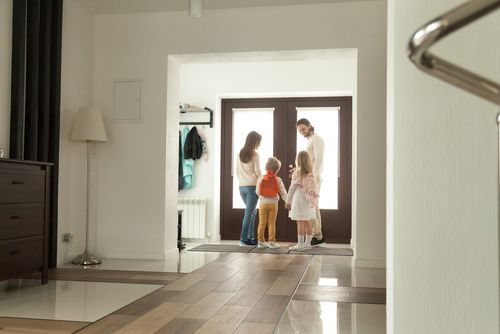We all want to be comfortable and warm at home when winter weather makes every effort to chill you to the bone. But, if you don’t know when to turn the heat on and off, your comfort could come at an exceptionally high price!
The biggest expense most homeowners have is for energy, in spite of differences between the types of energy used. Natural gas is the most cost-effective heat source, averaging out to more than $600 for the winter. For those who use oil, heat goes up to an average of over $1,400, while homeowners who rely on electric heat to keep their homes toasty fall in-between, at just under $1,000.
Homeowners have debated the pros and cons of when to turn the heat on and off for many years. While many argued that keeping the heat down while they weren’t home saved money, experts argue that it takes more energy to return the heating level to a comfortable one once you return home. Some opted to turn the heat off at night and rely on heavy bedding and/or electric blankets instead.
Although the debate still continues today, technology has brought about some changes to the argument. Making the right choices about heating your home starts with the right technology.
Should You Turn the Heat On or Off While Not at Home?
One part of the argument remains the same; it doesn’t make sense to heat your home when no one is there. That said, there are a number of factors to consider when answering this question. For example, how long are you gone during the day? Do you have pets that stay home alone? Do you have children who arrive home before you do?
The idea that it takes more energy to raise the temperature after it drops is simply untrue. Most people spend between eight and ten hours away from home, a minimum of five days each week. The amount of heat that it takes to heat your entire home during the 40+ hours you aren’t there is a lot! Compare the energy needs to maintain a comfortable period during this time to that needed to raise the temperature a few degrees.
There’s also the issue of heated air moving outside the home. Even the best insulated homes lose heat as it moves to colder areas. While this loss of heat might be gradual, your heat has to turn on to maintain the temperature setting. When the temperature drops outside, it takes even more energy to maintain the temperature level.
Turning back the thermostat during the day by 10° or more can result in energy savings of 10% or more, depending on your environment. It’s the greatest in milder climates where less energy is required to reach the comfortable temperature once the heat is turned on again.
On the other hand, every household isn’t the same. If it’s just you spending the day at the office, it’s easy to make the adjustment in temperature once you’re ready to come home. If there are other family members coming and going, it gets to be a lot more questionable about the benefits of turning the heat off while the house is empty.
Protecting Kids and Pets from the Cold
For many families, the first to arrive are the children from school. The last thing you want to do is welcome your kids home into a freezing house! Let’s face it; you can’t always count on them to take the initiative to turn the heat on once they arrive.
Sometimes pet owners overlook the well-being of their pets when left in a cold house all day. They don’t realize that their pets have problems adjusting to temperature changes just like they do. Even though your pet can regulate its body temperature to accommodate hot or cold weather, they aren’t as efficient at adapting to sudden changes. This is especially true for senior pets that have problems regulating their body temperature and are more susceptible to the cold.
Should You Turn the Heat Off at Night?
For some, the question of when to turn heat on and off focuses on the ‘when’. If turning the temperature down during the daytime isn’t practical, then maybe turning it down at night is. Granted, it’s usually a time when family members aren’t coming and going; but it’s also the time when you get your much-needed rest to stay healthy and keep your energy levels up!
Sleeping in thermal pajamas and plugging in an electric blanket is going to reduce the amount of heat your home requires. But turning the heat off at night isn’t a good idea for a number of reasons including:
-You won’t sleep as comfortably as you would in a reasonably warm room
Medical professionals advise against sleeping in temperatures below 60°F. Lower temperatures cause interruptions to sleep that reduce the quality and quantity of your rest.
-When temperatures reach freezing, your pipes are at risk of freezing and bursting, leading to extensive damage and the need for costly repairs
California isn’t exactly known for its freezing cold winters but it does happen. When unexpected freezes occur, you could pay with busted pipes and a flooded home.
-It still exposes family members and pets to unhealthy conditions that put them at risk
If you have family members who stay up late watching TV or studying for the next day’s math exam, they aren’t going to have the comfort they need or want in a cold home.
-It isn’t necessary
As mentioned earlier, technology has changed the debate about when to turn heat on and off. You don’t have to sacrifice comfort to save money on your energy bill.
Off vs Down: A Better Solution for You and Your Energy Bill
For the reasons listed here among others, turning your heat off during the day or night is never a good solution. Turning the heat down eliminates these issues, while still reducing the amount of energy you use.
We already mentioned that you save 10% off of your heating bill for every 10° you lower your thermostat. That means that lowering your thermostat by 1° will save 1%. So, for every degree you lower the temperature setting, you save 1% of your annual fuel costs.
Now, let’s say you typically keep your home thermostat set at 68°F. If you reduce that temperature to 60°F for eight hours each night, you can save $200 each year or more, depending on the type of fuel you use. If you do the same while you are gone during the day, you can double your savings. At the same time, you keep the temperature within the recommended sleeping range and stay well above the point of freezing.
The Smarter Thermostat for Home Energy Management
Once you work out a schedule of when to turn heat on and off and what temperature adjustments to make, the next challenge is remembering to make those changes. Most experts recommend getting a programmable thermostat to do the job for you. Once you determine a schedule, just program the details into the thermostat and it takes care of the rest.
Although programmable thermostats have made a world of difference to home heat management, nothing compares to the versatility of a smart home system. The right system allows you to manage your home’s temperature settings, monitor security, and even control light settings to optimize energy use and security when you’re away.
Smart home technology is a better way to reduce home heating costs when a schedule isn’t always reasonable. It addresses many of the issues surrounding knowing when to turn your heat down or off and puts total control within easy reach.
The flexibility of a smart security system makes it highly adaptable to you, your home, family, and lifestyle. If you have a pet at home, just set the temperature to a comfortable one in the areas where your pet stays. The smart system allows you to optimize temperature settings in every area of your home. Keep your pet warm and safe while reducing the temperature in the rest of the home while nobody is home.
How low do you want to go? A smart security system works from your smart phone. Either program the temperature adjustments you want into the phone or make them at will. Not only does it take the worry away that your kids will know when to turn heat on and off; it also lets you monitor when they get home from school and when they leave home again. It’s a great way for parents to have peace of mind. It does the same for pet parents!
If you schedule your thermostat to stay at eight degrees lower than normal during the day, the system can have the temp back to normal when you arrive. If you come home early or one of the kids gets the flu, no worries. Just set the thermostat to resume the normal temperature and have the house warm and ready when you arrive.
You are never too far from home to monitor and control your home’s security and energy usage. If you have your mobile device available, you can protect your home from any distance. A smart system is itself energy-efficient. All the options available to you can lead to as much as 50% savings on your annual energy bill!
Smart home systems also have features that help alert you to temperature-related issues in your home. Features like critical temperature alerts let you know when you need to address an issue.
Today’s smart security systems make it much easier to make your home look lived-in, even when you are miles away. Most of us know that turning lights on and off at different times is essential to deter thieves. In the past, the only tool available was a timer that turned the same lights on and off at the same time of the day or night.
A smart system allows you to program your lights according to a versatile schedule for a more realistic presentation. Would-be thieves who observe your home won’t know that you aren’t even there. The system also includes lighting features for the home’s exterior and, especially, the garage door entrance. Motion sensors ensure that there is never anyone lurking in the dark when you enter or exit your home.
The reason the question over when to turn heat on and off has been such a long one in answering is that every household is different. The same features that make you and your family comfortable don’t work for someone else.
A smart home offers the versatility that families need to keep their homes secure and safe. It comes through when the human memory (often) fails. It literally lets you control your HVAC system from anywhere and control other appliances in your home. If leaving the coffee pot or the stove on has been an issue in the past, a smart system can help save you from worry and unnecessary energy use.
Unlike your heating system, the more you use your smart home system, the more money you save. In addition to reducing the cost of heating during the winter, it also reduces your energy needs in the summer. Just set the system to keep the home warmer during the hours you aren’t at home. It can then restore cooling and have it ready for you to occupy by the time you get home!
Smart Shield Systems offers customized smart systems without the need for a learning curve. By offering a variety of packages, we give you the option to pay only for the features that you need. There’s no better way to add security to your home and take control of your home’s energy use year round.
Contact Smart Shield Systems to learn more about our systems. We can turn any house into a tailor-made smart home. We always provide state-of-the-art equipment and technology, customized to suit your home and lifestyle.



















